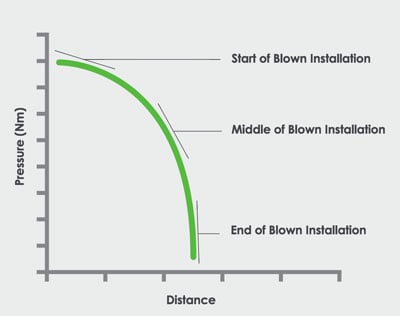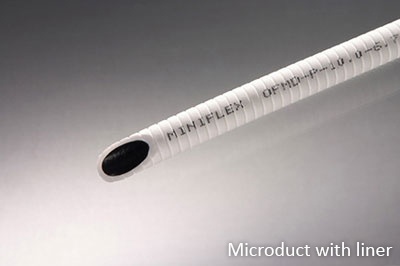 When it comes to deploying fiber, network planners have the options of blowing, pulling or pushing the cable. Each of these methods has different strengths and weaknesses, as we’ve covered in previous blogs.
When it comes to deploying fiber, network planners have the options of blowing, pulling or pushing the cable. Each of these methods has different strengths and weaknesses, as we’ve covered in previous blogs.
Generally, for the last drop pulling or pushing delivers the fastest, most efficient deployment - without needing to spend time setting up expensive and potentially messy blowing machines.
However, as you move towards the network backbone and, consequently, have to cover longer distances, blowing becomes a more feasible option - particularly if you have already invested in the equipment and skills needed to deploy it effectively.
How blowing works
When cable is blown through a microduct using compressed air, the propulsion comes from the pressure gradient caused when high pressure (in the blowing head) decays to atmospheric pressure at the route end.

The force this imparts to the cable is related to the gradient of the pressure versus distance plot (as shown in the graph). The gradient has a very small magnitude at the start of the route but a much larger magnitude at the route end.
Therefore, blowing distance is directly related to the weight of cable, the pressure used, and friction from the microduct liner. The first two of these are very visible – you can feel the weight and see the pressure on the blowing machine’s gauge.
Often, the contribution of the microduct liner is overlooked as it is hidden away, but it would be wrong to assume that every liner is equal in performance. Factors such as static build up in the microduct, caused by the liner, can severely limit the distance cable can be blown – and the speed that is achieved.
Keeping it slick
 We carried out a major project for a large incumbent European telco, where the liner properties were vital to its success. The operator was rolling out a fiber to the cabinet (FTTC) network, and had tight deadlines and budgets to meet.
We carried out a major project for a large incumbent European telco, where the liner properties were vital to its success. The operator was rolling out a fiber to the cabinet (FTTC) network, and had tight deadlines and budgets to meet.
It needed to deploy fiber over long distances, and wanted to optimize the use of its blowing machines and crews, so they could complete more work per day. The cable weight was fixed, and it knew the maximum pressure that its blowing machines could produce – the only way to improve efficiency was to look at the microduct liner.
Consequently, it ran a series of trials, looking at a range of liner materials and their properties. These included PPC's patented low static, low friction DVC liner. By making the blowing (or pushing process) easier, DVC enables cables to travel further, or crews to use less pressure to get the same results, reducing strain on equipment.
The third party run trials were carried out around the operator’s 1.5km (1 mile) and 2km test tracks, using an industry standard blowing machine. Liners were tested on 8 and 12 fiber microducts, under real-world conditions, and the results were clear. Microducts from three different manufacturers, including PPC, were used, in combination with fiber cables from two leading suppliers.
Using PPC microducts, with the DVC liner, delivered better performance across every combination of microduct size and cable. Overall, it provided up to 50 per cent greater blowing distance than the nearest competitor and was also 35 per cent faster when it came to installing fiber over specific distances. The design of several other microducts seemed to actually encourage static build up, harming their performance.
Some key results were:
- Using cable manufacturer number one, 8 fiber cable within PPC microduct was blown 1,600m (1 mile) in under 60 minutes – compared to 68 minutes for the nearest competitor and 67 minutes for the third.
- Using cable manufacturer number two, 8 fiber cable within PPC microduct was blown 2km in just under 70 minutes – compared to 1,100m in 78 minutes and 950m in 60 minutes for rivals. Essentially, the two competitors couldn’t even complete the test as they didn’t get to the end of the route.
- In a further trial, looking at different size microducts, 8 fiber cable within m2fx microduct was blown 1,600m in 42 minutes. This was nearly twice as fast as the competition, which achieved the same distance in 80 minutes.
- PPC 12 fiber cable within PPC microduct was blown 1,600m in just 30 minutes, under 12 bar pressure.
Having then selected PPC, the operator is benefiting from faster, longer, blown installs, which is directly leading to reduced deployment time and costs. There was no need for any additional training of crews or extra hardware, enabling the operator to maximize its existing investment in blowing machines.
The deployment is still ongoing, but has already successfully fibered up substantial parts of the country, bringing the power of fiber to millions of homes and businesses and enabling the operator to introduce new high speed services to its customers. This is all helped by the low friction liner, hidden within the microducts – demonstrating that not all liners are created equal, and that they can make an appreciable difference to performance, whatever cable you are using.


